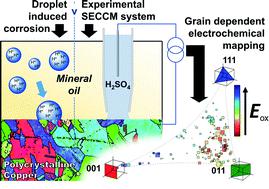当前位置:
X-MOL 学术
›
Chem. Sci.
›
论文详情
Our official English website, www.x-mol.net, welcomes your feedback! (Note: you will need to create a separate account there.)
Nanoscale electrochemistry in a copper/aqueous/oil three-phase system: surface structure–activity-corrosion potential relationships
Chemical Science ( IF 8.4 ) Pub Date : 2020-12-22 , DOI: 10.1039/d0sc06516a Enrico Daviddi 1 , Viacheslav Shkirskiy 1 , Paul M Kirkman 2 , Mathew P Robin 2 , Cameron L Bentley 1, 3 , Patrick R Unwin 1
Chemical Science ( IF 8.4 ) Pub Date : 2020-12-22 , DOI: 10.1039/d0sc06516a Enrico Daviddi 1 , Viacheslav Shkirskiy 1 , Paul M Kirkman 2 , Mathew P Robin 2 , Cameron L Bentley 1, 3 , Patrick R Unwin 1
Affiliation

|
Practically important metal electrodes are usually polycrystalline, comprising surface grains of many different crystallographic orientations, as well as grain boundaries. In this study, scanning electrochemical cell microscopy (SECCM) is applied in tandem with co-located electron backscattered diffraction (EBSD) to give a holistic view of the relationship between the surface structure and the electrochemical activity and corrosion susceptibility of polycrystalline Cu. An unusual aqueous nanodroplet/oil (dodecane)/metal three-phase configuration is employed, which opens up new prospects for fundamental studies of multiphase electrochemical systems, and mimics the environment of corrosion in certain industrial and automotive applications. In this configuration, the nanodroplet formed at the end of the SECCM probe (nanopipette) is surrounded by dodecane, which acts as a reservoir for oil-soluble species (e.g., O2) and can give rise to enhanced flux(es) across the immiscible liquid–liquid interface, as shown by finite element method (FEM) simulations. This unique three-phase configuration is used to fingerprint nanoscale corrosion in a nanodroplet cell, and to analyse the interrelationship between the Cu oxidation, Cu2+ deposition and oxygen reduction reaction (ORR) processes, together with nanoscale open circuit (corrosion) potential, in a grain-by-grain manner. Complex patterns of surface reactivity highlight the important role of grains of high-index orientation and microscopic surface defects (e.g., microscratches) in modulating the corrosion-properties of polycrystalline Cu. This work provides a roadmap for in-depth surface structure–function studies in (electro)materials science and highlights how small variations in surface structure (e.g., crystallographic orientation) can give rise to large differences in nanoscale reactivity.
中文翻译:

铜/水/油三相体系中的纳米级电化学:表面结构-活性-腐蚀电位关系
实际上重要的金属电极通常是多晶的,包括许多不同结晶取向的表面晶粒以及晶界。在这项研究中,扫描电化学电池显微镜 (SECCM) 与共位电子背散射衍射 (EBSD) 串联应用,以全面了解多晶铜的表面结构与电化学活性和腐蚀敏感性之间的关系。采用了一种不寻常的水性纳米液滴/油(十二烷)/金属三相配置,为多相电化学系统的基础研究开辟了新的前景,并模拟了某些工业和汽车应用中的腐蚀环境。在这种配置中,如有限元法 (FEM) 模拟所示,O 2 ) 并且可以提高不混溶液-液界面的通量。这种独特的三相配置用于对纳米液滴电池中的纳米级腐蚀进行指纹识别,并分析 Cu 氧化、Cu 2+沉积和氧还原反应 (ORR) 过程之间的相互关系,以及纳米级开路(腐蚀)电位,以一粒粒的方式。复杂的表面反应模式突出了高指数取向晶粒和微观表面缺陷的重要作用(例如,微划痕)在调节多晶铜的腐蚀性能方面。这项工作为(电)材料科学中深入的表面结构-功能研究提供了路线图,并强调了表面结构(例如晶体取向)的微小变化如何导致纳米级反应性的巨大差异。
更新日期:2021-01-19
中文翻译:

铜/水/油三相体系中的纳米级电化学:表面结构-活性-腐蚀电位关系
实际上重要的金属电极通常是多晶的,包括许多不同结晶取向的表面晶粒以及晶界。在这项研究中,扫描电化学电池显微镜 (SECCM) 与共位电子背散射衍射 (EBSD) 串联应用,以全面了解多晶铜的表面结构与电化学活性和腐蚀敏感性之间的关系。采用了一种不寻常的水性纳米液滴/油(十二烷)/金属三相配置,为多相电化学系统的基础研究开辟了新的前景,并模拟了某些工业和汽车应用中的腐蚀环境。在这种配置中,如有限元法 (FEM) 模拟所示,O 2 ) 并且可以提高不混溶液-液界面的通量。这种独特的三相配置用于对纳米液滴电池中的纳米级腐蚀进行指纹识别,并分析 Cu 氧化、Cu 2+沉积和氧还原反应 (ORR) 过程之间的相互关系,以及纳米级开路(腐蚀)电位,以一粒粒的方式。复杂的表面反应模式突出了高指数取向晶粒和微观表面缺陷的重要作用(例如,微划痕)在调节多晶铜的腐蚀性能方面。这项工作为(电)材料科学中深入的表面结构-功能研究提供了路线图,并强调了表面结构(例如晶体取向)的微小变化如何导致纳米级反应性的巨大差异。


























 京公网安备 11010802027423号
京公网安备 11010802027423号